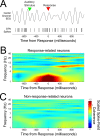Novelty-induced frontal-STN networks in Parkinson's disease
- PMID: 35297483
- PMCID: PMC9837604
- DOI: 10.1093/cercor/bhac078
Novelty-induced frontal-STN networks in Parkinson's disease
Abstract
Novelty detection is a primitive subcomponent of cognitive control that can be deficient in Parkinson's disease (PD) patients. Here, we studied the corticostriatal mechanisms underlying novelty-response deficits. In participants with PD, we recorded from cortical circuits with scalp-based electroencephalography (EEG) and from subcortical circuits using intraoperative neurophysiology during surgeries for implantation of deep brain stimulation (DBS) electrodes. We report three major results. First, novel auditory stimuli triggered midfrontal low-frequency rhythms; of these, 1-4 Hz "delta" rhythms were linked to novelty-associated slowing, whereas 4-7 Hz "theta" rhythms were specifically attenuated in PD. Second, 32% of subthalamic nucleus (STN) neurons were response-modulated; nearly all (94%) of these were also modulated by novel stimuli. Third, response-modulated STN neurons were coherent with midfrontal 1-4 Hz activity. These findings link scalp-based measurements of neural activity with neuronal activity in the STN. Our results provide insight into midfrontal cognitive control mechanisms and how purported hyperdirect frontobasal ganglia circuits evaluate new information.
Keywords: cognitive control; neuronal coherence; neuronal spiking; oddball task; prefrontal cortex.
Published by Oxford University Press 2022.
Figures








References
-
- Alegre M, Lopez-Azcarate J, Obeso I, Wilkinson L, Rodriguez-Oroz MC, Valencia M, Garcia-Garcia D, Guridi J, Artieda J, Jahanshahi M, et al. The subthalamic nucleus is involved in successful inhibition in the stop-signal task: a local field potential study in Parkinson’s disease. Exp Neurol. 2013:239(1):1–12. 10.1016/j.expneurol.2012.08.027. - DOI - PubMed
-
- Benjamini Y, Yekutieli D. The control of the false discovery rate in multiple testing under dependency. Ann Stat. 2001:29(4):1165–1188 https://www.jstor.org/stable/2674075.
-
- Bentley JN, Irwin Z, Black SD, Roach ML, Vaden RJ, Gonzalez CL, Khan AU, El-Sayed GA, Knight RT, Guthrie BL, et al. Subcortical intermittent Theta-Burst Stimulation (iTBS) increases theta-power in Dorsolateral Prefrontal Cortex (DLPFC). Front Neurosci. 2020:14(January):1–10. 10.3389/fnins.2020.00041. - DOI - PMC - PubMed
Publication types
MeSH terms
Grants and funding
LinkOut - more resources
Full Text Sources
Medical

